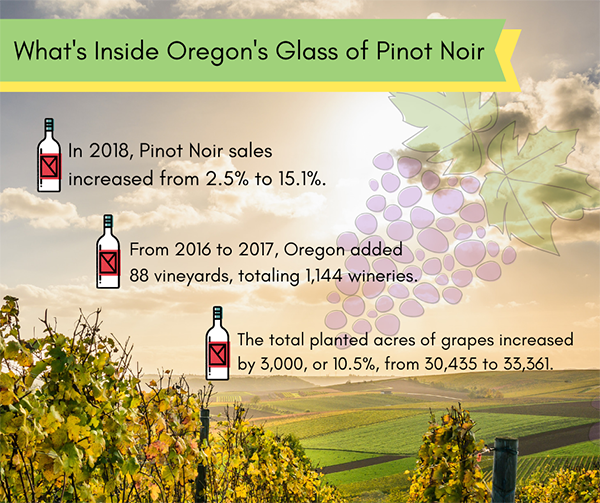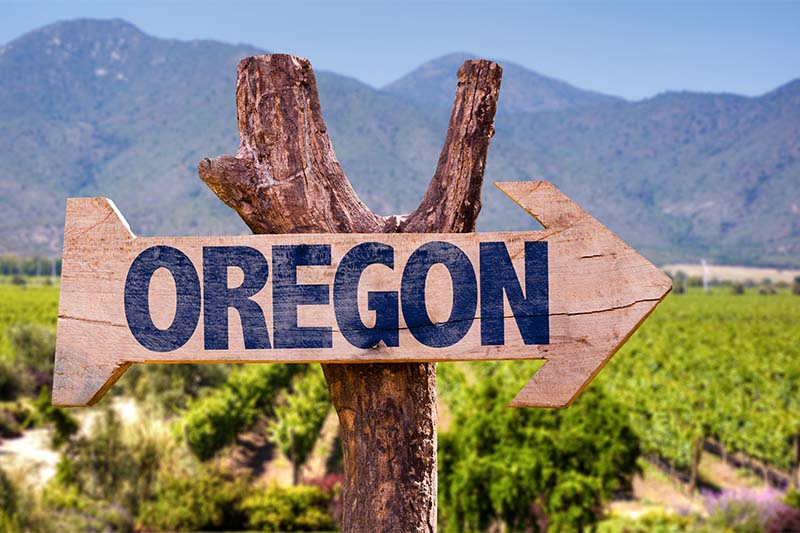With wildfires, climate change and overcrowding in California, Oregon—and most notably Pinot Noir—is having a moment.
Oregon ranks third as the largest wine producer in the United States, behind California and Washington.
From 2016 to 2017, Oregon added 88 vineyards, totaling 1,144 wineries. The total planted acres of grapes for wine increased by 3,000, or 10.5%, from 30,435 to 33,361.
California, of course, will always remain the dominant wine producer, but with its wildfires putting some wineries out of production for five years or more, Oregon is having its chance to shine.
Sales growth driven by wineries, not wholesale
Oregon boasted more than 3.6 million cases sold in 2017. Of the total sales, 21.5% were direct-to-consumer (DTC) sales in either tasting rooms, wine clubs, or internet sales.
Marketing to consumers via the DTC channel is a key factor in the state’s growth and health.
The Sonoma and Oregon wine regions saw a 19% growth of their direct-to-consumer channel last year.

Pinot Noir
There are 82 different types of grapes planted in Oregon, but when one thinks of Oregon wine, one usually thinks of Pinot Noir.
This remains the state’s signature grape, comprising 58% of all grapes planted in Oregon. Pinot Gris and Chardonnay represent the second and third largest grown grapes, respectively.
Overall, the Oregon wine industry is projected to have a double-digit growth trajectory, with its signature Pinot Noir established as Oregon’s leading grape varietal.
Consumers showed their love for Pinot Noir with their wallets. Last year, Pinot Noir sales increased 15.1%, compared to an industry-wide 2.5%.
“Oregon wine is compelling and thought-provoking,” Stacey Gibson, wine director and general manager of the former Woodsman Tavern of Portland, Oregon told Market Watch Magazine. “Every Pinot Noir reflects its vintage and vineyard, and Oregon’s cooler climate produces excellent acidity, even in a ripe vintage.”
High scores
Wine enthusiasts and lovers look to Wine Spectator each year to find out how vintages of wine performed year after year, and to discover any new emerging wines.
Wine Spectator’s coveted Top 100 Issue recognized Oregon with six Willamette Valley wines in its Top 100.
Think of it this way: That’s 6% of the total spots. It ranks as a new record for a state that only produces 1.5% of domestic wines.
How Oregon vineyards can ride the wave
It’s a great time for wineries in Oregon to stand out and gain new customers.
If you’re looking to expand, start with offering a great tasting experience for those that visit your winery. Tourists want to enjoy a tasting and sip wine overlooking your rolling hills. Then you can ask them to buy your wine.
Next, ensure you have a strong wine club or online sales arm of your business. This will allow customers to buy what they like after they taste it and keep coming back for more online long after their trip is over. You’ll also want to expand your social media footprint, as many millennials use sites such as Instagram to plan their vacations.
Finally, use analytics to see where your online sales are being shipped to. Then, use your marketing budget to target certain regions to save you from having to spend money to market nationally.
If you’re a producer outside of the state of Oregon, you can consider making an investment in a local family winery to expand your footprint and theirs.
- 87% of Utilities Have Experienced at Least One Data Breach in Last Three Years - February 5, 2024
- Can Drones Lower Your Next Utility Bill? - January 10, 2024
- Onshore Wind Farms Are The Next Big Thing In Renewable Energy - December 6, 2023




